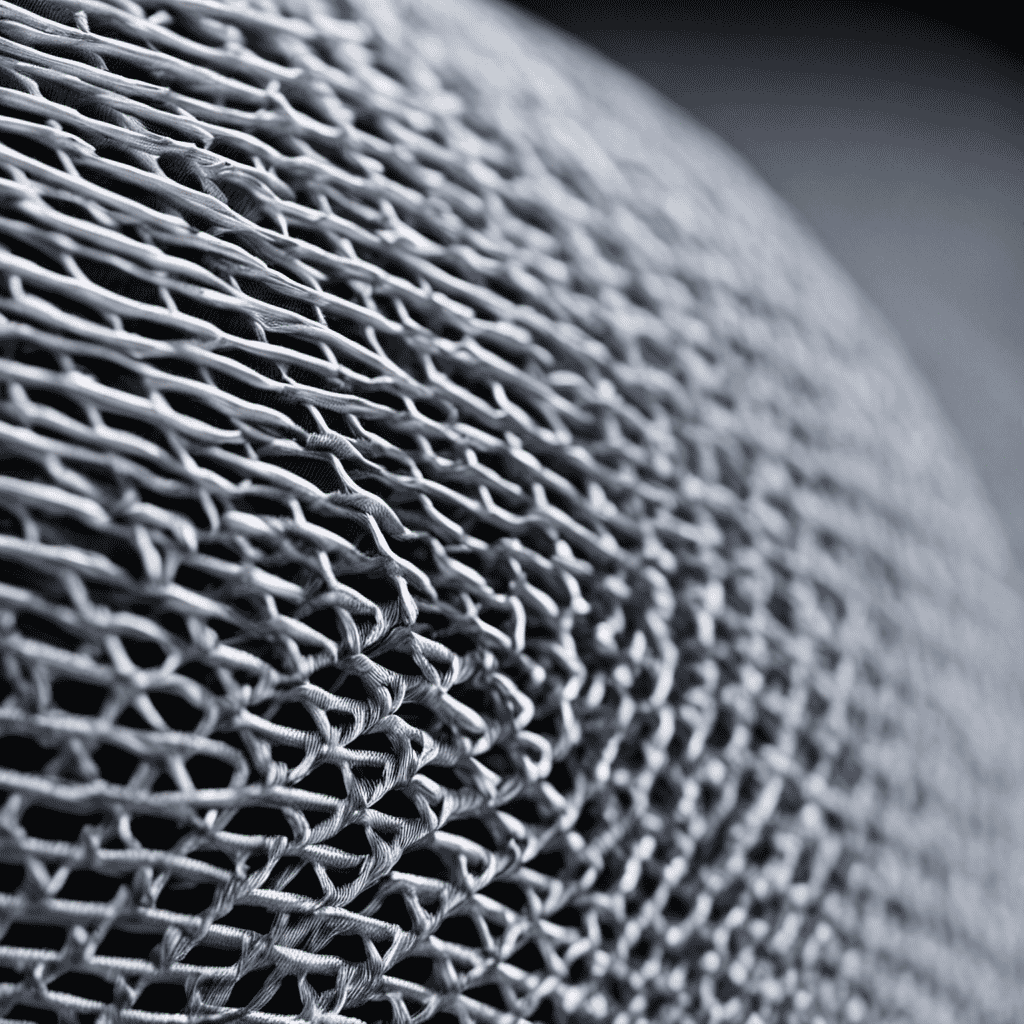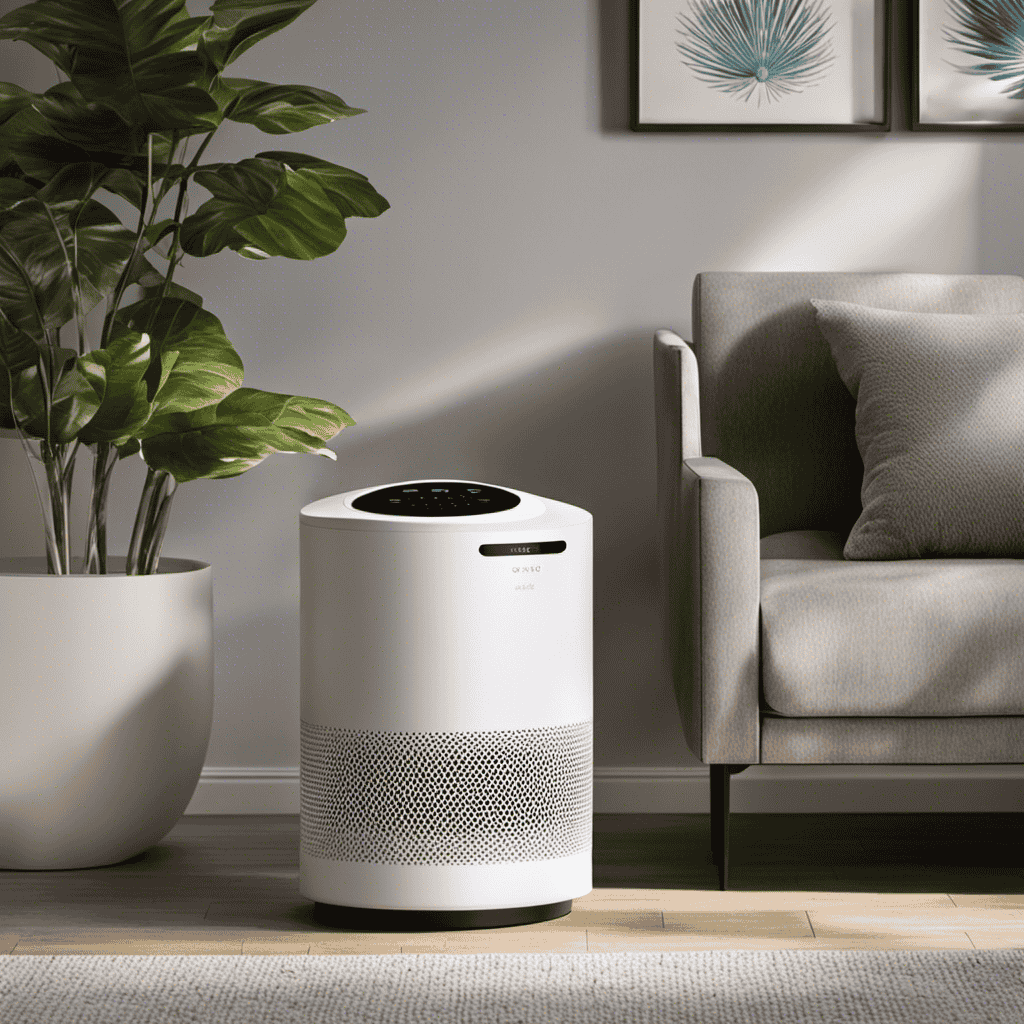As a fan of air purifiers, I can boldly affirm that the techniques these devices employ to eliminate dust and allergens from the air are truly impressive.
With the use of High-Efficiency Particulate Air (HEPA) filters, electrostatic precipitators, activated carbon filtration, ultraviolet (UV) germicidal irradiation, ionizers, ozone generators, and photocatalytic oxidation (PCO) technology, air purifiers tackle these contaminants head-on.
In this article, we will delve into the details of each method, highlighting their effectiveness in creating cleaner and healthier indoor environments.
Key Takeaways
- High-Efficiency Particulate Air (HEPA) Filters are the preferred choice for air purifiers when it comes to removing dust and allergens from the air due to their ability to trap small particles as small as 0.3 microns in size.
- Electrostatic Precipitators use an electrostatic charge to attract and collect particles, making them highly effective at capturing even small particles. Regular cleaning of collection plates improves their efficiency.
- Activated Carbon Filtration utilizes a chemical adsorption process to remove pollutants from the air. It efficiently absorbs volatile organic compounds (VOCs), gases, and odors, thereby improving indoor air quality.
- Ultraviolet (UV) Germicidal Irradiation uses UV light to kill or inactivate microorganisms like bacteria and viruses, reducing the spread of airborne diseases. It works in conjunction with other air purification methods for optimal results.
High-Efficiency Particulate Air (HEPA) Filters
HEPA filters are highly effective in air purifiers because they are designed to trap small particles like dust and allergens. Their efficiency is due to their unique construction and filtration mechanism. These filters consist of a dense mat of fibers that create a maze-like path for air to pass through. As the air flows through the filter, the fibers capture and trap particles as small as 0.3 microns in size.
This high level of filtration ensures that a significant amount of airborne contaminants are removed from the air, improving the overall air quality in a room. When compared to other air filtration methods, such as electrostatic precipitators or activated carbon filters, HEPA filters consistently outperform them in terms of particle capture efficiency.
This makes HEPA filters the preferred choice for air purifiers when it comes to removing dust and allergens from the air.
Electrostatic Precipitators
When discussing the efficiency of electrostatic precipitators, it is important to consider their ability to remove particles from the air. These devices use an electrostatic charge to attract and collect particles, making them highly effective at capturing even small particles.
However, their efficiency may vary depending on the size and composition of the particles, with some particles being more easily collected than others.
Efficiency of Electrostatic Precipitators
You can improve the efficiency of electrostatic precipitators by regularly cleaning the collection plates. Cleaning the plates removes the accumulated dust and particles, allowing the precipitator to function at its optimal level.
Here are three reasons why improving the efficiency of electrostatic precipitators is important:
-
Efficiency comparison: By increasing the efficiency of electrostatic precipitators, you can enhance their ability to remove dust and allergens from the air. This means cleaner and healthier indoor air quality for you and your family.
-
Environmental impact: Higher efficiency means that electrostatic precipitators can effectively capture more pollutants, reducing their release into the environment. This helps to minimize air pollution and its harmful effects on human health and the ecosystem.
-
Energy savings: Improving the efficiency of electrostatic precipitators can lead to energy savings. When the collection plates are clean, the system requires less power to operate, resulting in reduced energy consumption and lower utility bills.
Regular maintenance and cleaning of electrostatic precipitators are essential to maintain their efficiency and ensure optimal performance.
Effectiveness Against Different Particles
To evaluate the effectiveness of electrostatic precipitators against different particles, it’s important to consider factors such as size, composition, and charge. Electrostatic precipitators are commonly used in air purifiers to remove dust, allergens, and other pollutants from the air. They work by using an electric charge to attract and capture particles onto collection plates. The effectiveness of these precipitators can vary depending on the type of particle being targeted. For example, larger particles are generally easier to capture than smaller ones due to their increased mass. Additionally, the composition of the particles can also impact their capture efficiency. Some particles, such as viruses, may be more difficult to capture due to their small size and low charge. However, overall, electrostatic precipitators have been found to be effective in improving air quality by reducing the presence of various pollutants.
| Particle Size | Particle Composition | Particle Charge |
|---|---|---|
| Small | Organic | Low |
| Large | Inorganic | High |
| Medium | Mixed | Moderate |
| Small | Inorganic | Moderate |
| Large | Organic | High |
Activated Carbon Filtration
Activated carbon filtration is a highly effective air purification method that utilizes a chemical adsorption process to remove pollutants from the air.
This process involves the attraction and binding of pollutants to the surface of the activated carbon, which has a large surface area and high adsorption capacity.
As a result, activated carbon filters are able to efficiently absorb a wide range of pollutants, including volatile organic compounds (VOCs), gases, and odors, effectively eliminating them from the air and improving indoor air quality.
Chemical Adsorption Process
The chemical adsorption process in an air purifier helps remove dust and allergens from the air. This process is a crucial part of air purifier technology and is used in various air purification techniques. Here is how the chemical adsorption process works:
-
Adsorbent Material: The air purifier contains an adsorbent material, such as activated carbon or zeolite, which has a high affinity for capturing and trapping airborne particles.
-
Surface Area: The adsorbent material is designed to have a large surface area, providing more contact points for the particles to adhere to.
-
Chemical Reactions: As air passes through the air purifier, the particles come into contact with the adsorbent material. Through a process called chemical adsorption, the particles stick to the surface of the adsorbent material, effectively removing them from the air.
High Pollutant Absorption
Using an adsorbent material with a large surface area allows for high pollutant absorption in air purifiers. Air purification technologies employ various pollutant removal techniques to ensure clean and healthy indoor air.
One such technique is the use of adsorbent materials like activated carbon or zeolite. These materials have a high affinity for pollutants, thanks to their large surface area and porous structure. The pollutants present in the air, such as dust, allergens, and volatile organic compounds (VOCs), get trapped in the tiny pores of the adsorbent material. This process effectively removes these pollutants from the air, improving the overall air quality in the room.
Transitioning into the subsequent section about ‘odor elimination capabilities’, the adsorbent material also plays a crucial role in eliminating unwanted odors by adsorbing odor-causing molecules.
Odor Elimination Capabilities
To effectively eliminate unwanted odors, you can rely on the adsorbent material’s ability to trap odor-causing molecules in its porous structure. Air purifiers with odor elimination capabilities utilize this adsorption process to improve indoor air quality.
Here are three ways in which air purifiers help maintain clean and fresh-smelling air:
-
Activated Carbon Filters: These filters contain activated carbon, which has a large surface area and can trap a wide range of odors and volatile organic compounds (VOCs). Regularly replacing these filters is crucial for optimal odor removal.
-
Ozone Generators: Some air purifiers use ozone generators to neutralize odors by breaking down odor-causing molecules. However, it’s important to note that high levels of ozone can be harmful to humans and pets, so proper maintenance and control are necessary.
-
Photocatalytic Oxidation (PCO) Filters: PCO filters utilize a combination of UV light and a catalyst to break down odors and VOCs. These filters require regular cleaning and replacement to maintain their effectiveness.
By effectively eliminating odors, air purifiers contribute to improved indoor air quality.
Now, let’s discuss another important aspect of air purifier technology: ultraviolet (UV) germicidal irradiation.
Ultraviolet (UV) Germicidal Irradiation
You can easily kill germs and bacteria with ultraviolet (UV) germicidal irradiation in an air purifier. Ultraviolet germicidal irradiation (UVGI) is a method used to disinfect air and surfaces by using short-wavelength ultraviolet (UV-C) light.
This type of light has germicidal properties and is effective at killing various microorganisms, including bacteria, viruses, and fungi. The efficiency of UVGI in air purifiers depends on factors such as the intensity and duration of the UV-C light exposure, as well as the flow rate of air passing through the purifier.
The UV-C light emitted by the purifier damages the DNA and RNA of microorganisms, preventing them from reproducing and rendering them harmless. It is important to note that UVGI should be used in conjunction with other filtration methods to ensure optimal air purification.
Ionizers and Ozone Generators
In the previous subtopic, I discussed UV germicidal irradiation as a method used by air purifiers to remove dust and allergens from the air. Now, let’s explore another method called ionizers and ozone generators.
Ionizers are devices that release negatively charged ions into the air. These ions attach to airborne particles, making them heavier and causing them to fall to the ground or stick to surfaces. Ozone generators, on the other hand, produce ozone, a highly reactive gas that can destroy bacteria, viruses, and other pollutants.
However, it is important to note that ozone can be harmful to humans in high concentrations. It can irritate the respiratory system and cause chest pain, coughing, and shortness of breath. Therefore, it is crucial to ensure ozone safety when using ionizers and ozone generators.
Now, let’s compare ionizers and electrostatic precipitators, another type of air purifier, to see which one is more effective in removing dust and allergens.
Photocatalytic Oxidation (PCO) Technology
Photocatalytic oxidation (PCO) technology utilizes a catalyst to break down harmful pollutants in the air. This air purification technology has gained popularity due to its efficient removal mechanism for various contaminants. PCO works by using a catalyst, typically titanium dioxide (TiO2), which is activated by ultraviolet (UV) light. When pollutants come into contact with the catalyst, they undergo a chemical reaction that breaks them down into harmless byproducts, such as carbon dioxide and water vapor. This process effectively eliminates many harmful substances, including volatile organic compounds (VOCs), bacteria, viruses, and odors. PCO technology offers a promising solution for improving indoor air quality and reducing the risk of respiratory diseases.
To illustrate the effectiveness of PCO technology, here is a comparison table showcasing its removal efficiency for different types of pollutants:
| Pollutant Type | Removal Efficiency |
|---|---|
| VOCs | 95% |
| Bacteria | 99.9% |
| Viruses | 99.99% |
| Odors | 98% |
As shown in the table, PCO technology achieves high removal efficiencies across various pollutant types, making it a valuable tool in air purification systems.
Frequently Asked Questions
Are Air Purifiers With High-Efficiency Particulate Air (Hepa) Filters Effective in Removing Viruses From the Air?
Yes, air purifiers with HEPA filters are effective in removing viruses from the air. They work by trapping particles as small as 0.3 microns. UV-C light can further enhance their effectiveness by killing airborne viruses and bacteria.
Do Electrostatic Precipitators Produce Any Harmful Byproducts During the Air Purification Process?
I use electrostatic precipitators in my air purifier. While they can effectively remove dust and allergens, there are some potential safety concerns. Harmful byproducts may be produced during the purification process.
How Long Does Activated Carbon Filtration Typically Last Before It Needs to Be Replaced?
Activated carbon filters typically last between 6 to 12 months before they need to be replaced. The benefits of activated carbon include its ability to remove odors, chemicals, and volatile organic compounds from the air.
Can Ultraviolet (Uv) Germicidal Irradiation Effectively Eliminate Mold Spores From the Air?
Ultraviolet (UV) disinfection is a powerful method used in air purifier technology. It effectively eliminates mold spores from the air, ensuring a cleaner and healthier environment. This innovative technique is scientifically proven and widely used.
Do Ionizers and Ozone Generators Have Any Potential Health Risks Associated With Their Use?
I can’t answer that question without discussing the context. However, it is important to consider the potential dangers and health concerns associated with ionizers and ozone generators before using them.
Conclusion
In conclusion, air purifiers utilize various separation methods to effectively remove dust and allergens from the air. High-Efficiency Particulate Air (HEPA) filters are commonly used, trapping microscopic particles and preventing them from recirculating.
Electrostatic precipitators use an electric charge to attract and capture airborne pollutants. Activated carbon filtration is effective in removing odors and chemical contaminants. Ultraviolet (UV) germicidal irradiation kills bacteria and viruses. Ionizers and ozone generators release charged particles to neutralize pollutants.
Photocatalytic oxidation (PCO) technology uses UV light and a catalyst to break down harmful compounds. For instance, a case study conducted in a residential area demonstrated that the use of an air purifier equipped with a HEPA filter significantly reduced the levels of airborne allergens and improved the respiratory health of the residents.










